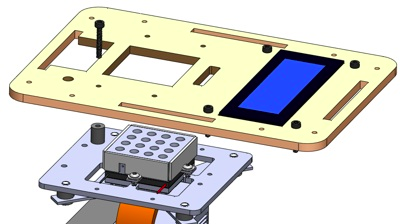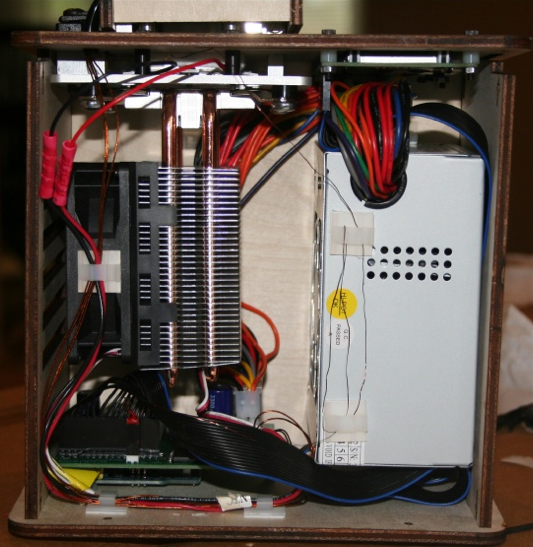OpenPCR: Now shipping

Over a year ago, we covered the OpenPCR project. Following their successful Kickstarter campaign, which netted twice their funding goal, they’re now actually shipping the devices.
To start, this is a $512 PCR machine (aka thermocycler). That’s roughly an order of magnitude below commercial machines. This puts it into the reach of classrooms, hobbyists, and underfunded laboratories.
Many PCR reactions are somewhat tolerant, and will proceed successfully in most cases. However, there are some “finicky” PCR reactions. Some researchers will swear by a particular machine for troublesome PCR reactions. Perhaps, since these units are so inexpensive, a lab could buy one for each researcher and then they can set it up the way they want to and never have to wait for machine scheduling in order to carry out their experiments.

About the software…
I suppose their focus was on easy-of-use. If so, mission accomplished. They programmed an Arduino to act like a USB drive. Then an Adobe Air application reads and writes to a file on the drive/Arduino in order to interface with the machine. In makes for a pretty interface, but it doesn’t allow for customized operation.
About the hardware…
Wood isn’t a great material to build laboratory appliances out of. Decontamination of wood is quite difficult, and often not practical. Plastic would work better.
But you can change these things to suit you
Whatever you want to do with it, you can. True to their name, all of the drawings, code, and schematics are freely available at: http://openpcr.org/downloads
(link)
This is a comment that Tito Jankowski of OpenPCR left on a different page. I’m copying it below, a better place for it, and the deleting where it was before (on the About page).
———–
Hi Spencer!
I’m excited to announce that we have shipped the first OpenPCRs, the world’s first open source PCR machine! I saw you were very interested in the Otyp PCR machine, so I’m sending you a note before our official announcement which will be posted tomorrow (Wednesday) morning. Here’s our announcement below with lots of new tales about OpenPCR (http://openpcr.org). Let me know if you have any questions or are interested in any other information!
Tito
Hi everyone,
The eagerly awaited OpenPCR kit is now shipping! UPS picked up the first batch of kits and OpenPCRs are on their way to users in 5 continents and 13 countries around the world. For $512, every OpenPCR kit includes all the parts, tools, and beautiful printed instructions – you ONLY need a screwdriver.
A PCR machine basically a copy machine for DNA. It is essential for most any work with DNA, things like exposing fraud at a sushi restaurant, diagnosing diseases including HIV and H1N1, or exploring your own genome. The guy who discovered the PCR process earned a Nobel Prize in 1993, and OpenPCR is now the first open source PCR machine.
The price of a traditional PCR machine is around $3,000. So, did people in garages have good PCR machines? Not really. Howabout high school or middle school teachers? Nope. Howabout smaller medical testing labs or labs in India or China? Nope. Even some big bio labs try their luck on eBay. We set out to change that.
Josh and I prototyped OpenPCR over about 4 months — it was a lot of fun. Last May we unveiled the first OpenPCR prototype to all you crazy people on Kickstarter, 158 people gave us a total of $12,121. With that we designed and manufactured a repeatable, works-all-the-time device — it took a lot of hard work. Now we’re done and ready to share!
OpenPCR Firsts:
1. First commercially available PCR machine for $512
We get a lot of people who come up to us and say “jumping jillikers, batman! we paid $10,000 for ours and it’s this big (make refrigerator-sized hand motion)!”. While modern PCR machines aren’t fridge sized anymore, we’re proud to say that OpenPCR is the most affordable and most compact PCR machine out there.
2. First Arduino USB device:
This is a big deal for you Arduino hackers out there. A normal Arduino can only talk back and forth over a serial port. This is a pain to set up, and we wanted OpenPCR to just plug-in and go. How does it work? When OpenPCR is plugged in, the Arduino mounts itself as a USB drive called “OpenPCR”. The computer passes love notes to OpenPCR by writing to that file, and Arduino sends love notes back by writing to another file. The implementation was tough, and there are size restrictions due to the size of the chips used by Arduino, but it’s pretty simple to make use of. Simply plug in your OpenPCR to your computer with USB. No setup besides downloading the OpenPCR app! (Josh and Xia totally pulled of a miracle on this!) If you’ve got questions on this specifically, be sure to post below! Josh will be blogging on this topic.
3. We’ve got 57 posts and 600+ comments on the OpenPCR blog, covering a lot of aspects of OpenPCR development. In the past few months we’ve kept our heads down getting everything out the door and we’ve got some stories to share. Short answer is, we’ve got a lot of blogging to catch up on.
Special thanks to Xia Hong, Eri Gentry, and Will Reinhardt who volunteered lots of their time to help OpenPCR.
No cutting corners
The clear vision of OpenPCR that made it great was driven by 2 things. First off, Josh is an incredible engineer and we both enjoyed learning a lot of new things over the past year — everything from how to make circuit boards, machine metal parts, laser cutting, Arduino hacking, USB hacking. I’d say 90% of the success of OpenPCR was lots of hard work. Hard work is great but there are lots of projects where hard work is put in but never “pays off”. How did we stay on course? I think the prototype + showing it off on Kickstarter/Maker Faire had a lot to do with it. We of course had lots of exciting ideas about new functionality and extra things over the past year. The beauty of having built our prototype was we knew if we could just get to that point we would have a hit.
For example, we designed OpenPCR to be assembled by hand. The printed Build Instructions are a big part of OpenPCR and we did a lot of work to get them right. As we finalized the OpenPCR design a few steps stood out as “hard”. We switched from thermal paste to thermal pads (not messy, no need for gloves), assembled circuit boards (no need for a pro soldering setup), and pre-epoxied the thermistor. The OpenPCR kit is easy to build because of those decisions. We’ve still got to publish the gel pictures showing how great OpenPCR works, but that’s been well tested ourselves. If you’ve got an OpenPCR kit coming your way and would like to post pictures of a gel run afterwards, we would love to see your results too!
The intent of the prototype was simple – we wanted a PCR machine for people like us. That meant a 16 well PCR machine controlled by computer, with a built in screen, good for the lab bench or a workshop/garage. And that’s exactly what OpenPCR is.
Where did the $12,121 go?
After Kickstarter started in May, we worked for going on 14 months now. Between Josh and I, I estimate we put about 3000 hours into OpenPCR, not counting the time leading up to the prototype. Even at a silly $30/hour that’s $90,000, and a more realistic estimate would be multiples of that. We also spent $25,000 on prototyping costs including machine shops, ordering samples, and making prototypes (and excludes the cost of the OpenPCR kits/prizes for Kickstarter). Where did the extra cash come from? Savings and credit cards. Overall, a rough estimate of the cost of developing OpenPCR was $115,000 of time and money.
Just the beginning
OpenPCR is designed for labs, classrooms, and garages. Tell your science-y friends about OpenPCR, “Like” us on Facebook, or write us and tell us that you stopped by!
Do you want to see us develop more breakthrough biotechnology? Along this journey we uncovered a lot of opportunities for PCR and other biological devices. We’re a new company and would love to meet other passionate people. Our hurdles right now are manufacturing (mechanical engineers!), distribution (sales + marketers!), and new hardware/software/bioware + industrial design. If you’re in the Bay Area and want to get in on making all this crazy DNA stuff useful to regular people, send us an email: contact@openpcr.org.
For more information, we’ve gotten a lot of media attention over the past year including http://openpcr.org/2010/12/openpcr-in-the-nytimes/ NYTimes, http://openpcr.org/2011/03/sexy-openpcr-in-gq-france/ GQ France, http://www.biotechniques.com/news/Cheap-PCR-new-low-cost-machines-challenge-traditional-designs/biotechniques-301745.html” Biotechniques, and http://www.usatoday.com/tech/science/2011-06-01-science-biopunk-hacker_n.htm USA Today.